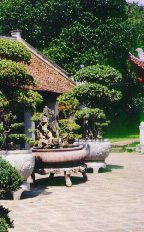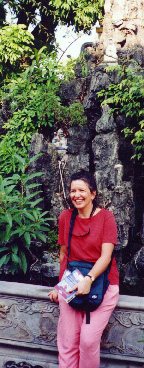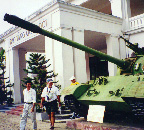



|
Since then, how many stars have spun and fled! Old horse and carriage paths &endash; faint autumn grass. Once-splendid towers and mansions &endash;
setting sun.
|
We found the Dien Luc Hotel, and indeed the entire Hanoi tourist industry to be quite accommodating to western tastes. The city, of course, has seen more of the French than the Americans. But I was beginning to get comfortable with the fact that English is the international language of Asia, and it was fairly easy to communicate one's needs and desires. In my case, that meant some eggs to go with rice and the odd dough-like bread balls. I just couldn't get on board with the whole soup-in-the-morning thing, though I had come to rely on noodles for sustenance. Our first order of business for the day was a visit to the Temple on the West Lake. Our hotel was a block from the East Lake, but the two are just a 10-minute bus ride apart. As the driver wedged the van into the last parking spot, though, I saw my worst fear realized, as a horde of t-shirts, books, and souvenir vendors enveloped us. |
|
|
|
|
|
We scampered across the causeway out to the temple, which thankfully was off-limits to commerce. The purpose of worship here was obscure. Our guide explained that it was a sect that worshipped "the mother" but it also appeared to be connected with the Buddhist tradition. The statues arrayed inside the open hall were also confusing. There were indeed statues of a mother figure, but most of the statues and the ones in the center, were clearly of males. What they had to do with good old Mutter went unexplained. And at long last Dong was frank -- "I don't know" he said helplessly. I was afraid that I had embarrassed him with my persistent questioning, so when we had a private moment I tired to explain the absolutely corrosive curiosity of us Americans. (Evidently other visitors brushed through with little comment.) We were very interested in these temples, I suggested, because many of us had read about Buddhism, but we wanted to learn how it was practiced in its different forms.
|
|
 Jackie June at the temple of the great mother on the West Lake. |
The temple was largely open, with the exception of a shuttered room for the monks. The open passageways and rooms ineluctably led to the back, a shaded courtyard on the lake. Obeisances were being made to the deity in a dark room open on its long side, facing the lake. Was it the mother, or a male? The only clues to the temple were on a plaque on the wall of an inner courtyard. It was built in 541-548 (using the western calendar), apparently in anticipation of the arrival of Buddhism, in the person of an Indian monk who preached there in 580. In 1959, the plaque stated, the President of India provided the temple with a boh-tree where the Buddha "had been sitting to operate his Zhen to become himself." In 1989 the government declared the pagoda a Cultural and Historical Relic. ("Relic" may be an inexact translation, but it does effectively convey the official attitude towards earlier historical periods.) We fought our way back to the bus, nearly losing Richard, who managed to get a red star for his pith helmet. The intrepid young vendor, suspecting more business in the offing, followed us on the back of a motorbike that artfully move its way through the traffic ahead of him and crossing impudently at right angles at each intersection. We thought that we had lost the urchin at one point, but he and his driver must have already deduced our destination-there simply aren't that many tourist attractions in the dour capital-and they reappeared triumphantly ahead of us. The bus summarily deposited us at the far end of East Lake, and we were politely encouraged to make ourselves scarce for an hour in the thin tourist district wrapped in a semicircle around the southern end of the lake. Here we were set upon by legions of peripatetic vendors, neatly dressed and speaking good English, who wished to sell postcards or bootleg copies of the Lonely Planet guide or Bao Ninh's novel, the Sorrows of War. I found refuge in the various shops where the walking vendors dared not go. The Vietnamese titles in the bookstores were limited in range. Computer books in all languages were a popular item. Translations of Freud were common, as well, perhaps significant in a country whose intellectual life has been survived only underground under the French, the Japanese, and so on to the present. Bao Ninh's novel was not to be found in Vietnamese -- after a brief heyday in the relaxed times of the early Nineties, it has been suppressed because of its terrifying portrayal of the effect of the "American War" on both the northerners and the Saigonese. (Bao Ninh has a second novel finished but has not been able to get it published in the country.)
|
|
Above, two stamps--a sculpture of indeterminate origin, and a colorful kite. To the right, a 2000 dong note, exchange value slightly more than one U.S. dime. |
I set out on a search for the Buu Dien (post office), running the gauntlet the whole way. I already had a ton of postcards, I had the Sorrow of War, but I needed stamps, which the street vendors did not have. A very persistent young man followed me, trying to get a conversation started that he hoped would broaden into a long-term financial relationship. He even accompanied me into the post office and tried to act as an intermediary for my purchase, to the annoyance of the well-dressed young woman behind the counter.
|
|
|
|
|
|
I lost him in front of the building, where an attractive woman in Western dress approached me with a smile and an open wallet containing a wad of dong. She wanted to buy dollars at 14,000 dong, a much better rate then the hotel, an indication of the thriving black market in foreign currency. Well within the hour, I was back at the place the bus had left us. I found that if I leaned unobtrusively on a street post and concentrated on furiously scribbling in my journal, most of the cruising vendors would give up on me fairly quickly -- possibly concerned about my sanity. Our next venture was a doomed sortie on bicycle to some of better-known attractions. While Hanoi had plenty of stoplights, the traffic never really came to a stop. When a phalanx of bicycles and trucks and motorbikes had to wait a few seconds after the green for the intersection to clear, it was inevitable that that line of traffic would continue to cross for a few seconds after the red. You had to gauge the alternating flow that constantly oscillated from starting just before the green to something closer to the red. Miraculously, we came out of it unscathed, though we witnessed a collision between two young men on a motorbike and a man on a bicycle just a lane over from ours. The bicycle rider looked dazed and surprised, but our guides urged us on before any of our humanitarian sentiments took over.
|
|

(photo by richard beattie) |
The bicycle trek took us to the Ho Chi Minh complex, dominated by a square with a grim-looking mausoleum whose exterior vaguely recalls the Lincoln Memorial. It was Soviet-style, and not by accident, as the Russians assisting the project evidently won out over the Vietnamese designers. Despite Ho Chi Minh's written request to be cremated, his body was pickled by the Russian taxidermists for display purposes. Unfortunately, he was not available for viewing at that time &endash; it was rumored that the body had been sent to Russia for its regular touch-up. Instead, we had a nice tour of the elegant little house where he was said to have lived and worked during the last years of his life. (d. 1969) It was tree-shaded and quiet, facing out towards a large pond. A bunker next to the house had been built as an air raid shelter when the bombing began. What could an American say about Ho Chi Minh, here in this place? I had demonstrated against our military involvement and the bombing, but that didn't mean I sympathized with the Communist philosophy. I softened a bit, seeing this quiet place. A possibly apocryphal story has Ho Chi Minh feeding the koi in the pond, so regularly that they were said to rise expectantly to ther surface when he approached. Perhaps he was not an unworthy figure to be revered as father of a country. After all, our founding fathers had their own imperfections, not the least being their keeping slaves. The Viet Minh and the Viet Cong were often ruthless, but how much more ruthless than the French or the Japanese? The questions see-saw back and forth. How could he doom so many of his country men to death by deciding to challenge a modern superpower to a test of wills? But then, how could he not, when we had so clearly ignored our own dictum of self-determination of the people? When the Japanese retreated, we backed the return of the colonial French, of all people. When the Viet Minh beat the French, we partitioned the country and tried to create a government for the South that would be more to our liking. When that didn't work we resorted to sending our own troops to tip the balance of power and relied on large-scale bombing to force our will on the country. How would we have reacted? The British can answer that question. We didn't get to tour the Ho Chi Minh museum, an imposing modern edifice that loomed behind the quiet pool. But there were other things to enjoy.
|
|
The dan bau, a one-string (monochord) instrument. The musician uses the "whammy bar" to change the tone, while plucking with her right hand. Right, a small t'rung in the background and the k'longput in the foreground, an odd instrument that is played simply by clapping one's hands in front of the bamboo pipes.
|
|
|
|
Some of us wandered into the gift shop where young women dressed a little too formally played a variety of folk instruments. It became far more interesting when they stopped trying to play to the tourist with a sing song rendition of "O Susanna" on the bamboo version of a marimba. From there we cycled at further risk to life and limb to the Temple of Literature, also known as the College of Van Mieu. Founded in the time of the Ly Dynasty, around 1076, this school trained future administrators (mandarins) in the precepts of Confucianism. Buddhism had become the religion of state during this period, and although Viet Nam won its independence from China the previous century, Ly Thanh Tong also adopted many features of centralized government from the northern neighbor. As we were to find out later in our stay, one of the popular themes in art and theatre was the return of the scholar after graduation to the village of his origin. This was more than a personal visit, the scholar is depicted returning in a great procession, mounted on horseback with flagbearers in the advance, to offer thanks to his ancestors. But there was little sign of that kind of public ceremony in this quiet and open compound. The temple had no center; it unfolded as a series of open courtyards, one with a pool, another a garden, and then buildings that could have been living quarters and others classrooms. Someone was playing "O Susanna" in a shop in one of the buildings. A bookstall was nestled in one doorway. I was buying books at an alarming rate, but couldn't resist a hardbound copy a French text on the customs, dress, and technologies of Vietnam. There were also the usual collection of English-language publications, including Giap's account of the siege at Dien Bieu Phu.
|
|
 The death toll from the Vietnam War (or the American, rather than the French phase of the war) will never be known. Many historians wisely refrain from attempting a full accounting of the military and civilian casualties on both sides. Guenter Lewy attempted one of the more careful (and conservative) estimates: the US/ARVN deaths at 282,000 and the VC/NVA dead at 444,000. An unknown number of civilians died in the north and south, with many of the latter victims ending up in the US/ARVN body count as hostiles. Lewy estimates that the total civilian dead was likely 627,000, which includes 65,000 civilian deaths as the result of bombings in North Vietnam and approximately 38,954 civilians assassinated by the Viet Cong in the South. By this count, 46% of the 1,353,000 war dead were civilians, most of them in the South. --Guenther Lewy, "America in Vietnam," 1978, Oxford University Press |
I was afraid that the Army Museum would be the hardest thing to take, but it turned out not to be overtly offensive. Much of it was devoted to the war against the French, which was a more heroic subject -- there was no victory such as Dien Bien Phu in the war against the Americans. I followed a party of French through the displays of flame throwers and diorama of the fateful valley where 10,000 French soldiers surrendered in 1954. In one room of the French war, I saw a party of Soviets being given a tour of the displays by a Vietnamese woman in military dress. Ironically, she was lecturing them in English and one of the party was translating her descriptions into Russian for the others. The American war was on display in a newer building in back. There were a few pictures of the Americans -- a photo of a Vietnamese prisoner being tortured, the Marines landing at Da Nang. A cutaway model of the Cu Chi tunnels gave a tidy picture of the underground network of caves, bunkers, dens, and corridors where so many Viet Cong and civilians lost their lives. But there was no mention of the terrible losses -- from the staged photographs of smiling, confident soldiers firing rifles or loading mortar rounds, war appeared to be one long glorious procession of victories. That left some puzzling gaps. If the Viet Cong had successfully attacked and entered Saigon, Hue and other cities during the 1968 Tet offensive, what happened in the next seven years before Saigon fell? The typewritten cards next to the pictures and displays left some other oddities unexplained. The account of the Tonkin Gulf incident in 1964 described a "mine-launching ship" chasing the U.S. Madock (Maddox), "shooting down one American aircraft on the spot." Even though the White House appeared to be spoiling for a pretext to enlarge its war powers, no damage to an American plane or warship was ever claimed or documented. In the front of the building, on the first floor, was the most moving and honest testimonial to the suffering of the Vietnamese; two rooms of photographs and letters documenting the sacrifices of "the Heroic Mothers". Some had lost 4 or 5 children, less frequently six or seven. And husbands and brothers. The honors accorded the mothers came slowly, according to Templar, because the government had been reluctant to acknowledge the full extent of the military and civilian casualties. On a dare between us, Bee and I hiked up the twisting steep staircase of the Flag Tower to take in the view. From that height, the city appeared mostly to be a sea of roofs, with seams and pockets of green treetops. It was a low skyline, with nothing standing out but the modern high-rise hotels. I'm ashamed to say that after dinner some of us forsook the "Love Planet" for a fancier joint, in the hopes of finding a faster connection and more available computers. Hanoi had an "Emotions" cybercafe, evidently part of the same chain as the one in Ha Long. This was almost a new wave club, with a dimly lit bar on the first floor (the Bee Gees singing about a mining disaster in the background). Up two flights of a narrow staircase we found an air conditioned room behind glass, with a full complement of computers, and settled in for our nightcap and a little cybersurfing.
|